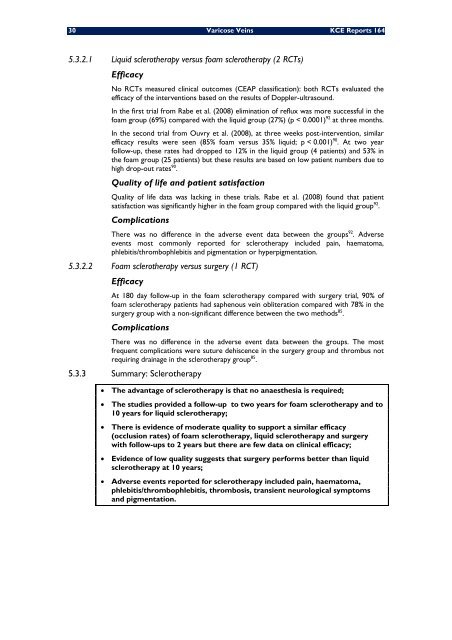Diagnostic et traitement des varices des membres inférieurs - KCE
Diagnostic et traitement des varices des membres inférieurs - KCE
Diagnostic et traitement des varices des membres inférieurs - KCE
You also want an ePaper? Increase the reach of your titles
YUMPU automatically turns print PDFs into web optimized ePapers that Google loves.
30 Varicose Veins <strong>KCE</strong> Reports 164<br />
5.3.2.1 Liquid sclerotherapy versus foam sclerotherapy (2 RCTs)<br />
Efficacy<br />
No RCTs measured clinical outcomes (CEAP classification): both RCTs evaluated the<br />
efficacy of the interventions based on the results of Doppler-ultrasound.<br />
In the first trial from Rabe <strong>et</strong> al. (2008) elimination of reflux was more successful in the<br />
foam group (69%) compared with the liquid group (27%) (p < 0.0001) 92 at three months.<br />
In the second trial from Ouvry <strong>et</strong> al. (2008), at three weeks post-intervention, similar<br />
efficacy results were seen (85% foam versus 35% liquid; p < 0.001) 90 . At two year<br />
follow-up, these rates had dropped to 12% in the liquid group (4 patients) and 53% in<br />
the foam group (25 patients) but these results are based on low patient numbers due to<br />
high drop-out rates 90 .<br />
Quality of life and patient satisfaction<br />
Quality of life data was lacking in these trials. Rabe <strong>et</strong> al. (2008) found that patient<br />
satisfaction was significantly higher in the foam group compared with the liquid group 92 .<br />
Complications<br />
There was no difference in the adverse event data b<strong>et</strong>ween the groups 92 . Adverse<br />
events most commonly reported for sclerotherapy included pain, haematoma,<br />
phlebitis/thrombophlebitis and pigmentation or hyperpigmentation.<br />
5.3.2.2 Foam sclerotherapy versus surgery (1 RCT)<br />
Efficacy<br />
At 180 day follow-up in the foam sclerotherapy compared with surgery trial, 90% of<br />
foam sclerotherapy patients had saphenous vein obliteration compared with 78% in the<br />
surgery group with a non-significant difference b<strong>et</strong>ween the two m<strong>et</strong>hods 85 .<br />
Complications<br />
There was no difference in the adverse event data b<strong>et</strong>ween the groups. The most<br />
frequent complications were suture dehiscence in the surgery group and thrombus not<br />
requiring drainage in the sclerotherapy group 85 .<br />
5.3.3 Summary: Sclerotherapy<br />
• The advantage of sclerotherapy is that no anaesthesia is required;<br />
• The studies provided a follow-up to two years for foam sclerotherapy and to<br />
10 years for liquid sclerotherapy;<br />
• There is evidence of moderate quality to support a similar efficacy<br />
(occlusion rates) of foam sclerotherapy, liquid sclerotherapy and surgery<br />
with follow-ups to 2 years but there are few data on clinical efficacy;<br />
• Evidence of low quality suggests that surgery performs b<strong>et</strong>ter than liquid<br />
sclerotherapy at 10 years;<br />
• Adverse events reported for sclerotherapy included pain, haematoma,<br />
phlebitis/thrombophlebitis, thrombosis, transient neurological symptoms<br />
and pigmentation.

















